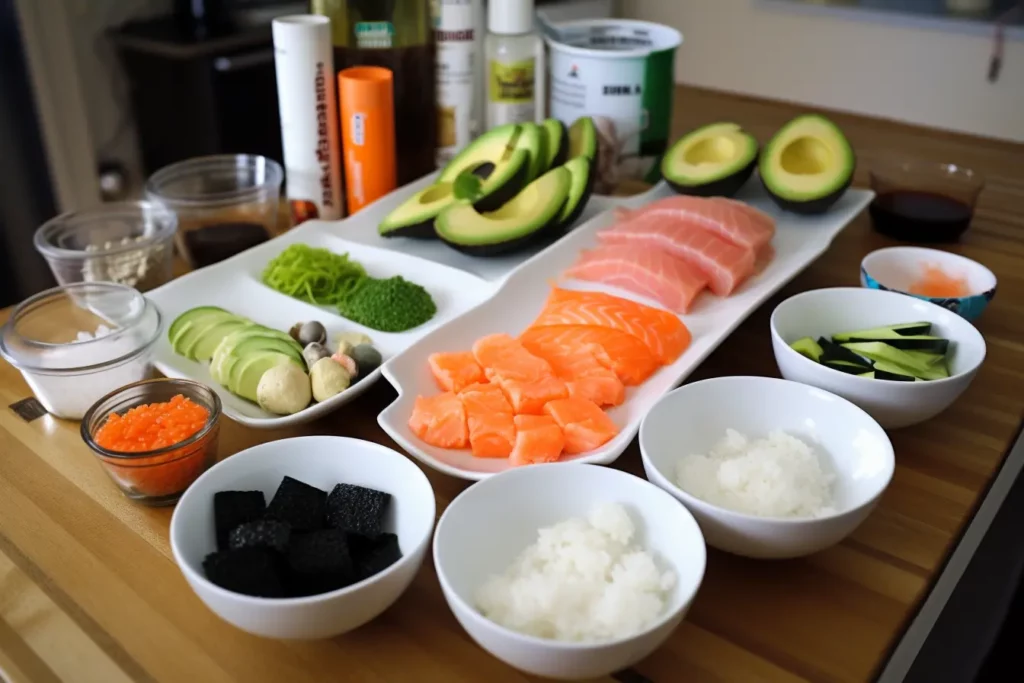Introduction
Wasabi is one of the most important ingredients in Japanese cuisine and plays a crucial role in the preparation of sushi. In this blog post, we’ll take an in-depth look at the importance of wasabi in sushi creations and take a closer look at its origins, as well as its importance in Japanese cuisine.
Origin of Sushi
The history of sushi dates back several centuries and has evolved steadily over time. Originally, sushi was developed as a method of preserving fish in rice. Over the years, new ways of preparing it have been developed, with sushi now being one of the most popular and well-known dishes in Japanese cuisine.
Another important ingredient in sushi is wasabi, a pungent green paste made from the root of the wasabi plant. This pungent paste not only gives sushi its characteristic pungent taste, but also serves as a natural preservative and provides health benefits for the body.
Wasabi’s Importance in Japanese Cuisine
In traditional Japanese cuisine, wasabi is often used in conjunction with raw fish to bring out its fresh flavor and kill any unwanted bacteria. In addition, wasabi is also valued for its health benefits, as it possesses anti-inflammatory and antimicrobial properties.
The importance of wasabi in Japanese cuisine extends far beyond the preparation of sushi. It is also used in other traditional dishes such as sashimi, tempura, and various soups to add extra spiciness and flavor to the food.
Wasabi’s influence on taste
Wasabi is an important ingredient in sushi creations and has a significant influence on the taste. The spicy spice gives traditional Japanese dishes a special touch and provides an intense taste experience.
Flavour-enhancing properties
The pungent and aromatic properties of wasabi have a flavor-enhancing effect on the various components of sushi. They ensure that the fish, rice and seaweed leaves taste even more intense and the aromas unfold on the tongue. This makes every sushi dish a real treat for the palate.
Combinations with different types of sushi
Depending on the type of sushi, wasabi can be combined in different ways. In the case of delicate types of fish such as salmon or tuna, often only a small amount of wasabi is used so as not to overpower the taste of the fish. On the other hand, for sushi varieties with stronger flavors such as eel or prawns, a little more wasabi can be used to achieve a harmonious balance of flavors.
Possibilities for combining wasabi with different types of sushi are many and can be varied according to personal preferences and culinary experimentation.
Health Aspects of Wasabi
Wasabi, a typical ingredient in Japanese cuisine, is prized not only for its pungent taste, but also for its potential health benefits. The natural ingredients of wasabi contribute to the promotion of health in a variety of ways.
Wasabis Natural Ingredients
The pungent taste of wasabi is created by mustard oils such as allyl isothiocyanate, which have anti-inflammatory and anti-microbial properties. In addition, wasabi also contains vitamin C, potassium and fiber, which can have a positive effect on health.
Some studies suggest that the mustard oils in wasabi may aid digestion and reduce the risk of heart disease and cancer. In addition, wasabi’s anti-inflammatory properties could help reduce inflammation in the body.
It is important to note that the potential health benefits of wasabi remain the subject of research and that further research is needed to confirm its exact effects on human health. Still, consuming wasabi regularly as part of a balanced diet can provide many health benefits.
Preparation and presentation
The preparation and presentation of sushi creations play a crucial role in the culinary experience. If you want to learn more about different sushi variations, check out my post on sushi variations .
Traditional Methods of Wasabi Preparation
In traditional Japanese cuisine, wasabi is made from fresh wasabi rootstock, which is finely grated to maintain its characteristic zesty spiciness. This traditional process requires patience and care to preserve the full aroma of the wasabi and offers an authentic taste experience.
Modern interpretations in sushi restaurants
Modern sushi restaurants often use alternative methods of preparing and presenting wasabi to vary the flavor and visual experience. Some restaurants offer wasabi in various forms, such as wasabi mayonnaise or wasabi jelly, to provide guests with a variety of dining experiences.
If you want to experience new interpretations of wasabi at a sushi restaurant, I recommend looking for terms like “modern wasabi creations” or “innovative wasabi presentations” on the menu to discover the latest trends.
The Role of Wasabi in Creative Sushi Cooking
Wasabi is an essential ingredient in traditional sushi cuisine, but this pungent green paste also plays a significant role in modern creative sushi art. The use of wasabi in creative sushi cuisine offers exciting opportunities to reinterpret traditional dishes and create innovative flavor combinations.
Innovative Wasabi Dishes in Modern Sushi Art
Modern sushi art creates innovative wasabi dishes that are a fusion of traditional Japanese flavors and modern culinary influences. From wasabi-infused sauces to roasted wasabi powder toppings, these creative dishes offer guests a unique taste experience that delights traditional sushi enthusiasts and experimental foodies alike.
The Future of Wasabi in Sushi Innovations
The future of wasabi in sushi innovation promises exciting developments in creative cuisine. With increasing internationalization and the fusion of different cooking techniques and ingredients, wasabi will continue to play an important role in the creation of new sushi creations. Wasabi’s versatility and spicy touch make it an indispensable component for future sushi innovations that push the boundaries of traditional cuisine and explore new culinary horizons.
Closing remarks
I hope this article has helped you better understand the importance of wasabi in sushi creations. The pungent green paste not only complements the flavor of sushi, but also plays an important role in improving digestion. The next time you eat sushi, don’t forget to try some wasabi and enjoy the unique spiciness and freshness it has to offer. Thanks for reading!
FAQ
Q: What role does wasabi play in sushi creations?
A: Wasabi is a spicy green root vegetable that is commonly used in Japanese cuisine as a condiment for sushi. It gives the sushi creations a pungent and spicy taste.
Q: Can you order sushi without wasabi?
A: Yes, many restaurants will serve sushi without wasabi if the guest so requests. You can also ask for the wasabi to be served separately so that you can decide for yourself how much of it you want to use.
Q: What are the health benefits of consuming wasabi?
A: Wasabi contains anti-inflammatory and antibacterial properties. It can help promote digestion and boost the immune system. It is also said to be effective against bacteria and fungi.
Q: Why is wasabi often mixed with soy sauce?
A: The combination of wasabi and soy sauce creates a perfect balance of spiciness and saltiness that is ideal for sushi. Many people prefer to dip their sushi pieces in a mixture of soy sauce and wasabi to intensify the flavor.
Q: Are there any alternative uses for wasabi in the kitchen?
A: Yes, apart from being used in sushi creations, wasabi can also be used as a condiment for other dishes such as marinades, dressings, or dips. You can use the pungent aroma of wasabi in many ways to add a special touch to different dishes.


